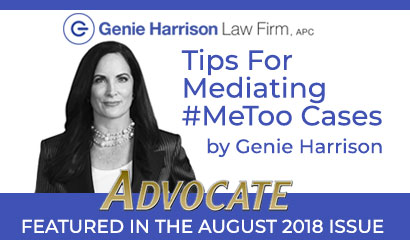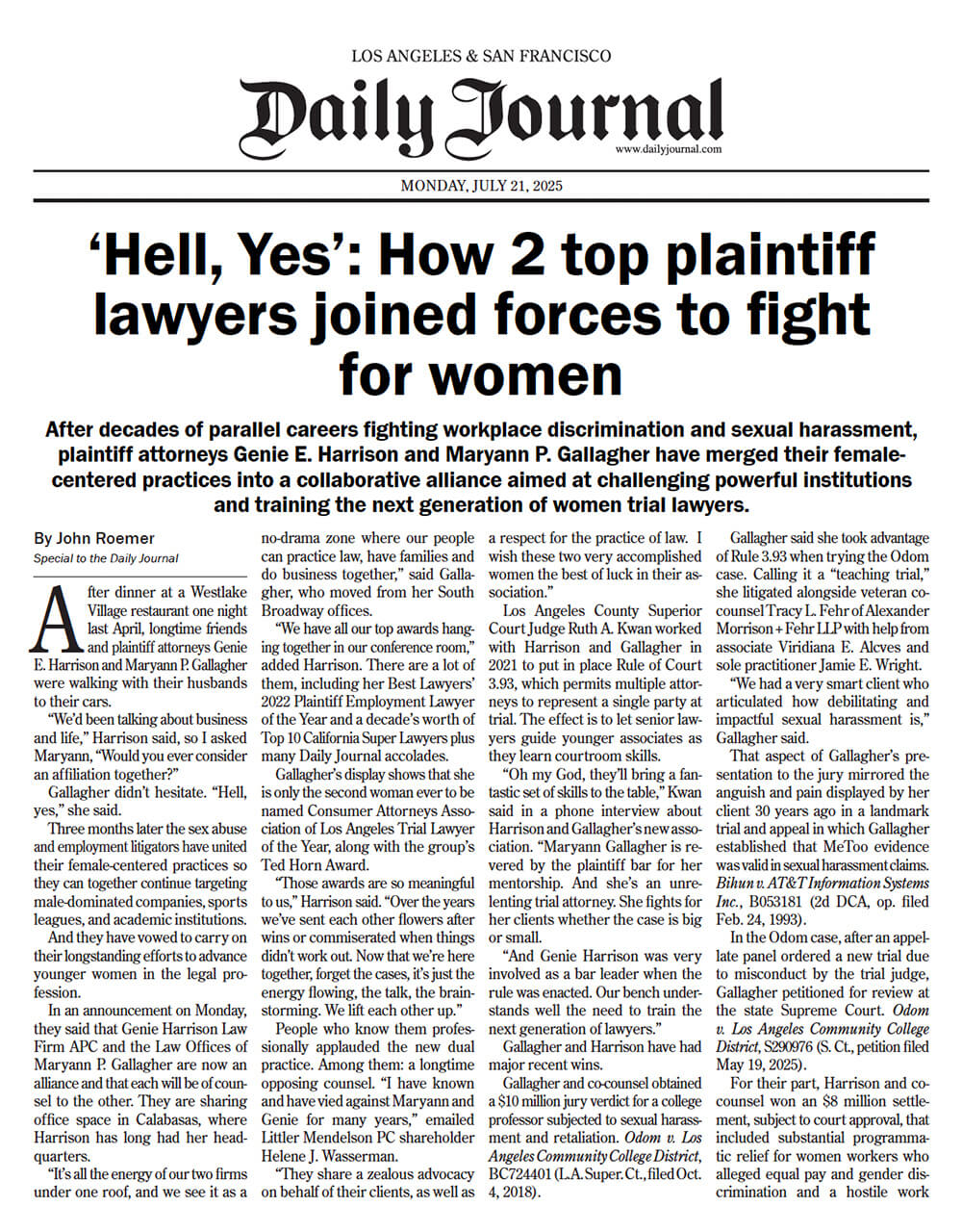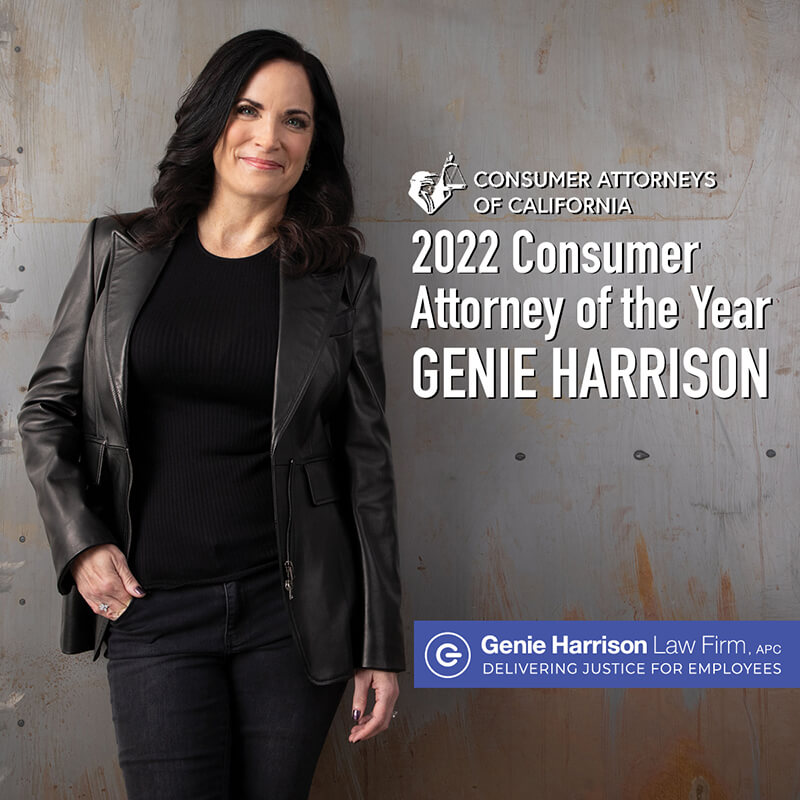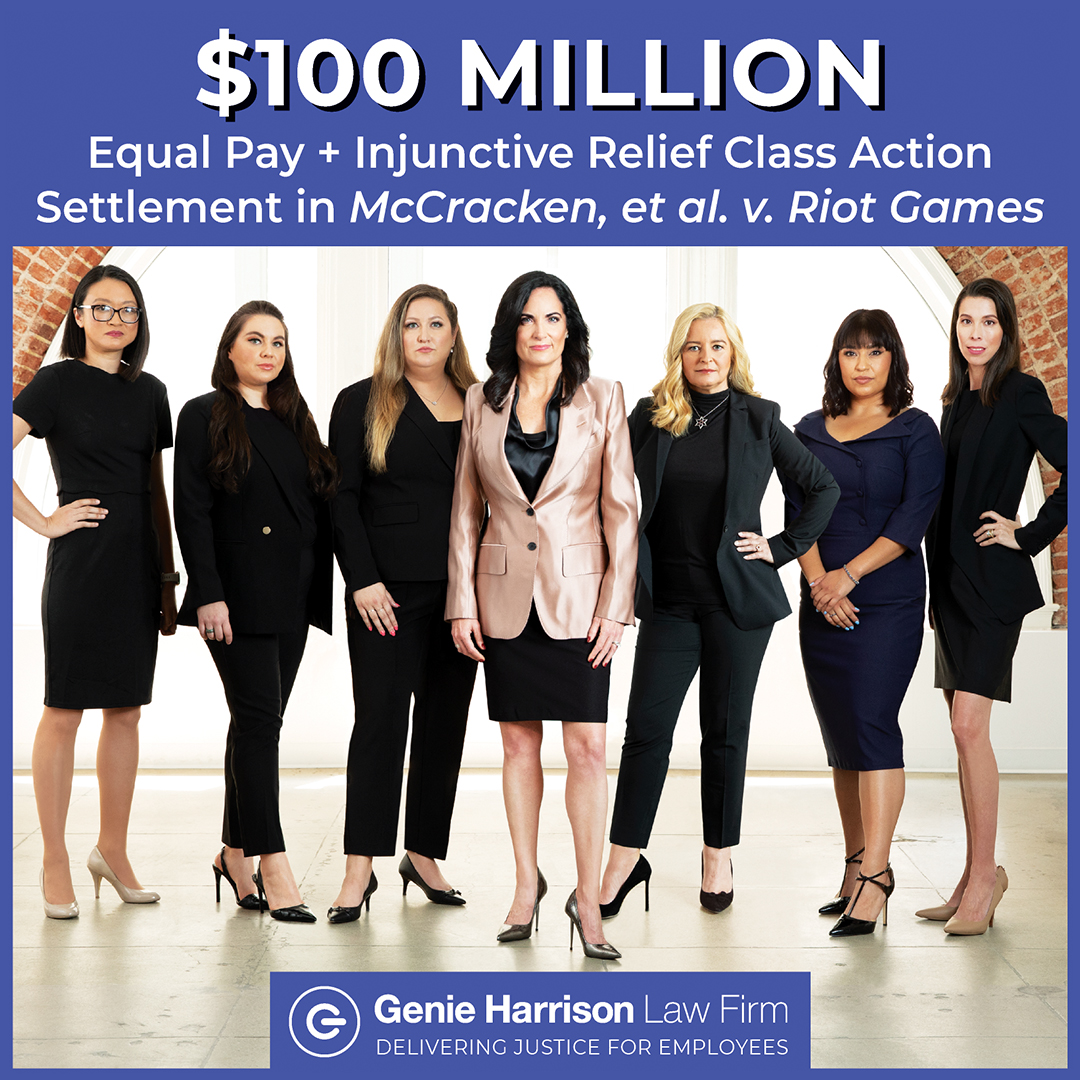Tips For Mediating #MeToo Cases
Learn and embrace HerStory, let her show you by reenactment exactly what happened
August 2018 Issue of The Advocate — by Genie Harrison of the Genie Harrison Law Firm
Read the complete story below, or download the pdf HERE
Sexual harassment and abuse is not new. There is not “more” sexual harassment occurring now. Rather, as a society we are paying more attention; we are listening.
Likewise, the challenges inherent in the alternate dispute resolution processing of sexual-harassment cases have not changed. Defenses are fairly predictable, as are the problems preparing and assisting clients through the process. In this article I will provide you with three tips to help you prepare for and handle the mediation.
Embrace the victim’s history, HerStory
One of the most important things I have learned to do is discover and embrace my client’s full history as a human being. Only in understanding her history, going all the way back to childhood, can I be prepared to tell the story of her harm.
I cannot explain to any decision maker – whether that’s the mediator, corporate representative, insurance adjustor, or jury – what my client’s motivations, or her harms and losses have been unless I understand her. I think credit goes to CAALA member Debbie Chang (Panish Shea Boyle) for saying something along the lines of this: We cannot understand what was lost until we understand what the plaintiff had.
So how do we do this? I start with what I call a “Client Wellness Questionnaire” through which I gather information going back to my client’s childhood. Among other things, I find out about how her family interacted with one another, including on crucial topics; whether she felt loved and supported; whether she fit in or was an “outsider” in school and how that shaped her; whether she has experienced traumas and how she handled those experiences; her history of therapy and treatment; and her current circumstances. The answers I receive help me understand her, explain and frame the case.
The firefighter
By way of example, in one of my firefighter cases I learned that my client decided to become a firefighter when, at the age of six, her house burned to the ground when the local fire department was not able to arrive quickly enough to save the home. She dreamed of saving families’ homes and she worked hard for over fifteen years with that single goal in mind. It meant everything to her to serve the public, saving them from the trauma and pain she and her family experienced when they lost their home. When she was pushed out of the fire department in retaliation for complaining about sexual harassment, and other unlawful conduct, she fell apart. She wasn’t just sad because she lost a “job”; she quite literally lost her reason for being. And in hearing that story, a jury can understand why she was so devastated. How can they value her harm without understanding why she was a firefighter to begin with?
This is a digestible example that makes a lot of sense, which is why I began with this example. But things get much more complex in sexual-harassment cases.
In these cases, we often find that the victim has been previously victimized. But, our clients usually don’t want to talk about these prior incidents, and many of us are extremely uncomfortable hearing about them. The first thing we must do is accept that it’s uncomfortable for all of us to have these conversations. We are all uncomfortable thinking about prior abuse, because that abuse is appalling; we relive it when we retell it; we imagine it happening to us when we hear someone else tell the story of their abuse, and, let’s be honest, for many of us there are instant questions:
“She was abused before, so she’s already damaged and doesn’t the harm go back to the original injury?”; “There must be something about how she interacts with people that somehow contributed to this happening again”; and, “Why does what he did to me now have anything to do with what happened to me back then?” But we must talk about all of it, because those experiences shaped her and help explain both why she did what she did in handling the current abuse, and the harm she suffers now.
So, we must flip the script.
Prior abuse is where as advocates, instead of thinking “no” or “stay away,” we must say, “yes, and,” both in our minds and out loud – to our client, to the mediator, and to defense counsel.
Here’s an example. Yes, she was raped as a child … and yet, she persevered. She studied, she graduated, she earned this job, and she succeeded, or she was adequate in this job. Until, her boss sexually harassed her, touched her without her consent, made her feel powerless to stop him. Why? Because her economic survival depended on it. She was doing what we tell Americans to do – pick yourself up by the bootstraps and fight on. Earn your keep. She thought she had found balance, the ability to work, to do well and live in the present, instead of being haunted by the past. And she had all of that, plus her self-esteem, and her hard-earned dignity, until he abused his power. He took it all away and the company facilitated that harm because it left him unchecked through prior incidents. So yes, now she is agoraphobic, or has panic attacks, and has moved back in with her parents. Correct. She cannot now function. But that’s a risk of harm that the defendant assumed when it allowed the boss to continue working and abusing his power.
That, ladies and gentlemen, is how we must flip the script on the “but she was already a victim” storyline from the defense.
Your client will understand why you ask about prior incidents, and want to explore them more fully, if you explain why it’s so important to tell her full story. After all, it’s the truth – and healing comes from owning and telling the story.
Show them what happened
“He raped me. Why doesn’t anyone believe me?”
“Who would I complain to? He is the company.”
“I was so ashamed. Why did he think it was okay to force me into a relationship? I couldn’t stomach going to work; I just felt so powerless.”
These are among the questions and comments that we, as victims’ rights advocates, often hear from our clients – and they are at the core of what we have to address in advocating on our clients’ behalf.
In mediation we have to be prepared to address the defense framing of these questions. In my opinion, framing is one of the most important tasks in which we engage as victims’ rights advocates. One of the most effective mechanisms for framing that I have learned begins with reenacting the events. (As an urgent cautionary note, I urge you to use the services of an experienced psychodramatist and/or therapist when reenacting traumatic events. Reenacting trauma leaves the client feeling extremely vulnerable and connected to the distress they have suffered from the unlawful conduct, so you must anticipate and provide for their need for support.)
In many of these cases, the events occur when only the perpetrator and victim are present. Short of an audio or video recording of the events, which is prohibited in California unless all parties consent, how will one prove what happened in the private setting? I suggest reenactment.
The pizzeria
In one case, we reenacted how a middle-aged man, who owned the pizza restaurant where my 16-year-old client worked, spoke to the victim, urged her to drink beer, moved her into a back room, and grabbed her off the floor, pulling her onto his body. My client thought that the last thing she would ever tell us was that she drank when she was under age. She blamed herself for drinking, but the story played out very differently, of course.
Had we thought to ask in a Q&A whether she ever drank beer at work – I would not have thought to ask that question at the time – I’m sure she would have denied doing so. But we didn’t ask. We found out about the drinking by having her show us the events. In the moment, she was acting out the events and just showed us the truth about what happened next.
I frame this story as follows: a disgusting 45-year-old man routinely hires pretty teenagers, feeds them beer at work in order to groom them and lower their defenses, and then physically overpowers and sexually batters his minor employees. Through the reenactment process, my client learns how I see the events and discovers that she was manipulated. I show her that she has nothing to be ashamed of. And, we don’t get caught in the litigation or mediation having her dissemble out of fear when the question “Did you drink beer at work?” is asked.
This was a good example of using reenactments to learn about and frame the events. I have used reenactments to learn the details of rapes, abuses of power at work, messaging by those who receive complaints of harassment, and the internal feelings of panic when having to be around the harasser.
It was consensual
In one mediation, the defense had plausible evidence that a sexual relationship between a supervisor and subordinate was allegedly “voluntary.” But I reenacted the initial rape for the mediator to show the incident’s true nature, all the way down to the detail of the supervisor taking the victim’s purse into his room and depriving her, an immigrant, of her work visa. She had to go into the room to try to get her purse back. Once in there, the perpetrator closed and locked the door, and positioned himself in front of the door, trapping her. The sex that happened in that room was not consensual. Once this was clear, my client’s explanations of her boss’s later threats to deprive her of her job, and send her home against her will, had much more credibility.
Recently, I was reenacting the first time the harasser made my client feel threatened. My client remembered what was on the radio when that years-old incident occurred. My client reenacted that scene, and some details from others, to show that the events were real. The power in these details is undeniable and we must uncover these details to do the story of our clients’ victimization justice.
Fully inform and empower your client
As a survivor myself, I recognize that it is crucial to recovery that I help my clients take back their power. Truly listening to them, caring enough to discover their histories, and understanding and presenting their stories to help them stand up for themselves, are important components of shifting power back into their reservoir. But I also must fully inform them about the mediation process, ensuring that they have realistic expectations of what can and cannot happen through a mediation.
One of the worst things I can do as a victims’ rights advocate is deprive my clients of the information they need to understand the mediation process. If she is not informed and her experience does not match her assumptions or expectations, she can feel re-victimized and betrayed by the process – and by me. That would deliver the opposite of what I try to provide to my clients.
And I must let them have the final say on whether or not to resolve the matter.
The power and the choices were taken from my client – she was not able to choose whether or not to be subjected to unwelcome harassment, battery, retaliation, job loss, etc. Part of her healing is being given back the choice, the power to say yes or no, freely and voluntarily, to resolution. This gift of power and choice is, in my opinion, one of the most important gifts we can give to our victim clients.
If you haven’t been victimized, it may not be possible to understand how important it is to be able to stand up for oneself and be given the power over whether to continue the fight, versus choosing to end it. Having the power to stop a dispute process that one wants to have end does not erase the victimization, but it gives the victim the ability to choose to transition to survivor. She did not have the choice about whether to be victimized, but she owns the choice about whether to end the fight and transition fully into survivor. That’s a gift of unimaginable value which we are so lucky to have the opportunity to provide.
Conclusion
Any competent attorney can add up past lost or future lost wages in sexual-harassment cases. In my opinion, the challenges in these cases are rooted in getting the history, HerStory, so we understand the victim’s actions and inactions, and the harm, and in presenting the events in a framework that defuses the defense’s attacks. And finally, I hope that you see the incalculable value in fully informing your clients and giving them the gift of the power to end the fight with dignity, if that is what they choose to do.
 Genie Harrison is the principal of the Genie Harrison Law Firm, where she focuses on plaintiff’s employment, civil rights and wage and hour matters. Ms. Harrison is one of only two women in the state of California named by the Daily Journal as a Top Labor & Employment Lawyer for five years in a row. She has been recognized by Best Lawyers in America for Plaintiff’s Employment Litigation and been named by the Daily Journal as one of the Top 100 and Top 75 Women Litigators in California. In 2014 she was elected as a Fellow of the College of Labor & Employment Lawyers. In 2013 Ms. Harrison received CAALA’s Presidential Award.
Genie Harrison is the principal of the Genie Harrison Law Firm, where she focuses on plaintiff’s employment, civil rights and wage and hour matters. Ms. Harrison is one of only two women in the state of California named by the Daily Journal as a Top Labor & Employment Lawyer for five years in a row. She has been recognized by Best Lawyers in America for Plaintiff’s Employment Litigation and been named by the Daily Journal as one of the Top 100 and Top 75 Women Litigators in California. In 2014 she was elected as a Fellow of the College of Labor & Employment Lawyers. In 2013 Ms. Harrison received CAALA’s Presidential Award.







